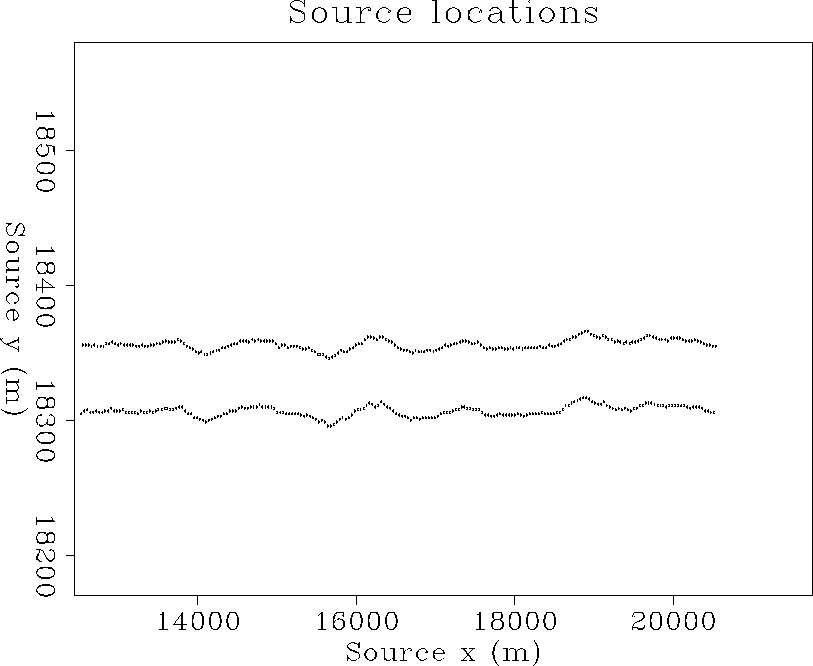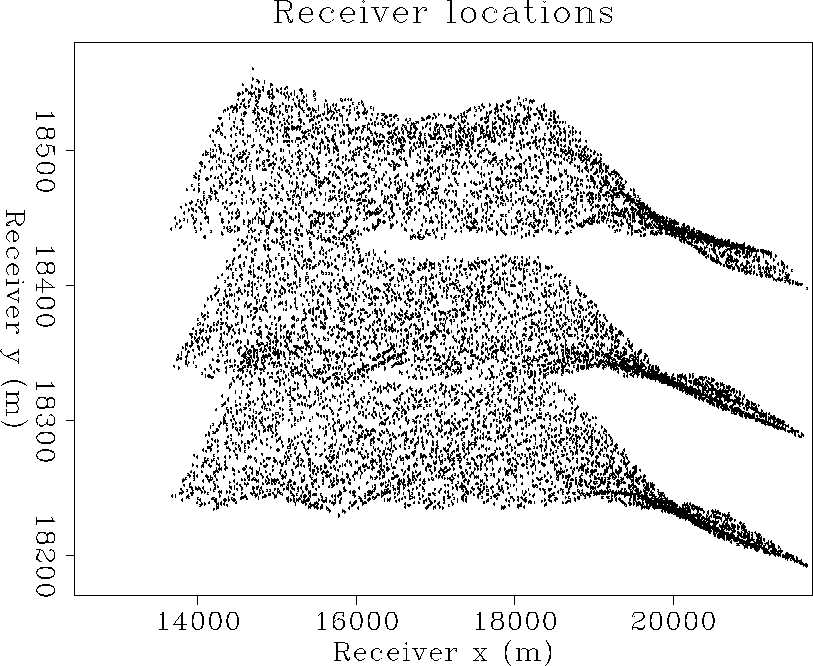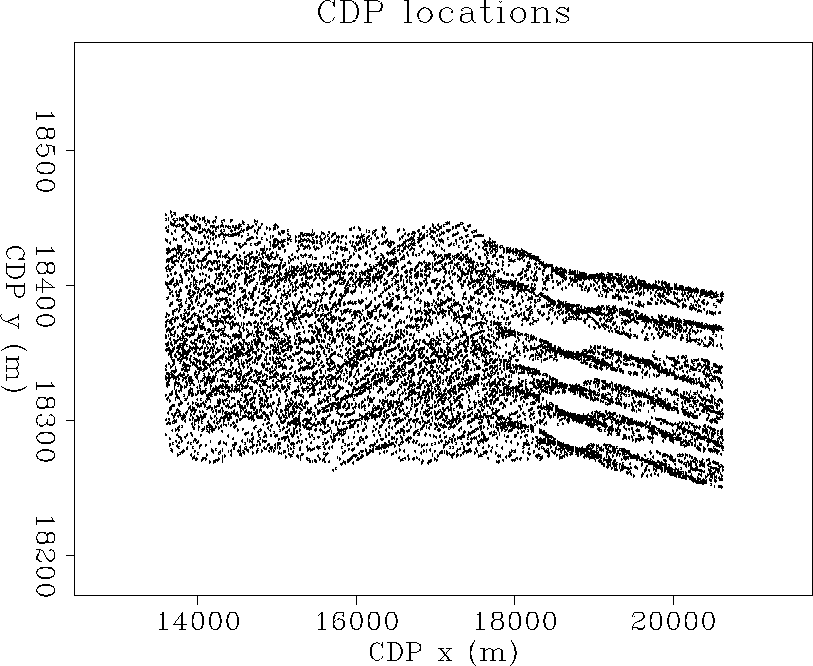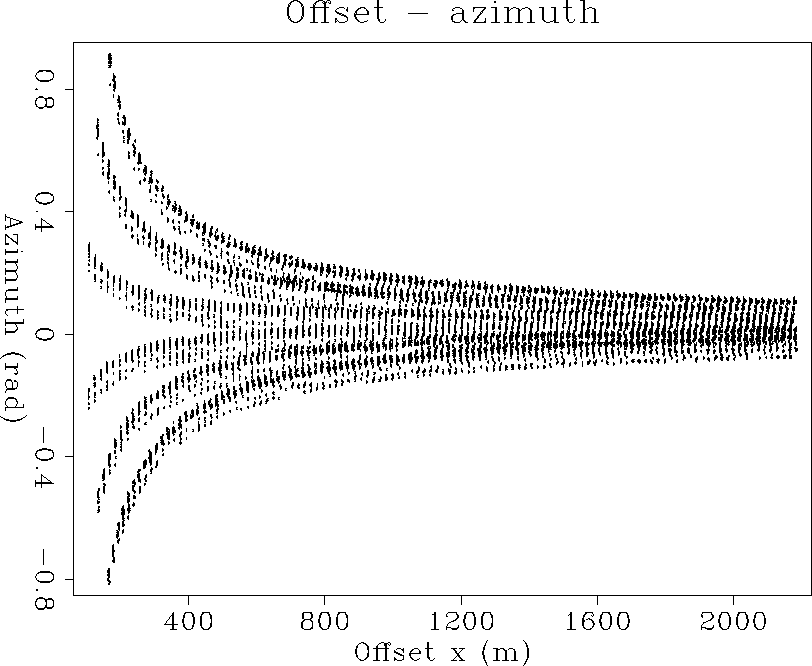




Next: Exploring the data
Up: Biondi, Clapp & Crawley:
Previous: TRACE FILTERING EXAMPLE
The following example shows how
to use SEPlib90 programs and libraries
to analyze and manipulate 3-D prestack
seismic data sets.
The data set is a single sail line belonging to a 3-D marine data
set recorded in the North Sea.
The data were recorded by shooting from two sources located at the stern of
the recording ship into three streamers being pulled behind the ship.
There are about 120,000 traces with 500 time samples in the data.
The total size of the Data Values File is about 250 Mbytes.
Figure ![[*]](http://sepwww.stanford.edu/latex2html/cross_ref_motif.gif) shows the source locations, for one trace out of ten
in the data set.
Figure
shows the source locations, for one trace out of ten
in the data set.
Figure ![[*]](http://sepwww.stanford.edu/latex2html/cross_ref_motif.gif) shows the receiver location for the same subset of
traces in Figure
shows the receiver location for the same subset of
traces in Figure ![[*]](http://sepwww.stanford.edu/latex2html/cross_ref_motif.gif) .
The receiver locations are scattered along the cross-line
direction (y) because of a fairly strong cable feather,
probably caused by ocean currents during acquisition.
The corresponding CMP locations are shown in Figure
.
The receiver locations are scattered along the cross-line
direction (y) because of a fairly strong cable feather,
probably caused by ocean currents during acquisition.
The corresponding CMP locations are shown in Figure ![[*]](http://sepwww.stanford.edu/latex2html/cross_ref_motif.gif) .
The cable feather caused a noticeable irregularity
in the CMP coverage, with cross-lines overlapping in many places.
Figure
.
The cable feather caused a noticeable irregularity
in the CMP coverage, with cross-lines overlapping in many places.
Figure ![[*]](http://sepwww.stanford.edu/latex2html/cross_ref_motif.gif) shows the trace offset-azimuth distribution.
Each of the six different trends distinguishable at small offsets
corresponds to a source-streamer pair.
shows the trace offset-azimuth distribution.
Each of the six different trends distinguishable at small offsets
corresponds to a source-streamer pair.
Sxy
Figure 3 Source locations of data traces
|
|  |





Rxy
Figure 4 Receiver locations of data traces
|
|  |





CDPxy
Figure 5 CDP locations of data traces
|
|  |





OFFAZ
Figure 6 Offset-azimuth of data traces
|
|  |










Next: Exploring the data
Up: Biondi, Clapp & Crawley:
Previous: TRACE FILTERING EXAMPLE
Stanford Exploration Project
11/12/1997
![[*]](http://sepwww.stanford.edu/latex2html/cross_ref_motif.gif) shows the source locations, for one trace out of ten
in the data set.
Figure
shows the source locations, for one trace out of ten
in the data set.
Figure ![[*]](http://sepwww.stanford.edu/latex2html/cross_ref_motif.gif) shows the receiver location for the same subset of
traces in Figure
shows the receiver location for the same subset of
traces in Figure ![[*]](http://sepwww.stanford.edu/latex2html/cross_ref_motif.gif) .
The receiver locations are scattered along the cross-line
direction (y) because of a fairly strong cable feather,
probably caused by ocean currents during acquisition.
The corresponding CMP locations are shown in Figure
.
The receiver locations are scattered along the cross-line
direction (y) because of a fairly strong cable feather,
probably caused by ocean currents during acquisition.
The corresponding CMP locations are shown in Figure ![[*]](http://sepwww.stanford.edu/latex2html/cross_ref_motif.gif) .
The cable feather caused a noticeable irregularity
in the CMP coverage, with cross-lines overlapping in many places.
Figure
.
The cable feather caused a noticeable irregularity
in the CMP coverage, with cross-lines overlapping in many places.
Figure ![[*]](http://sepwww.stanford.edu/latex2html/cross_ref_motif.gif) shows the trace offset-azimuth distribution.
Each of the six different trends distinguishable at small offsets
corresponds to a source-streamer pair.
shows the trace offset-azimuth distribution.
Each of the six different trends distinguishable at small offsets
corresponds to a source-streamer pair.



